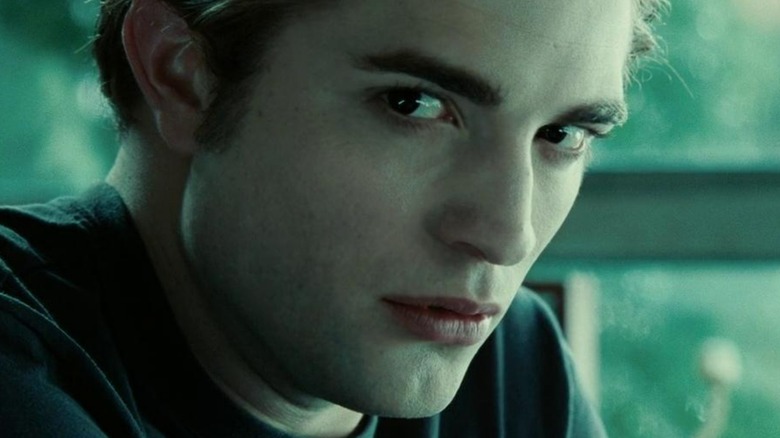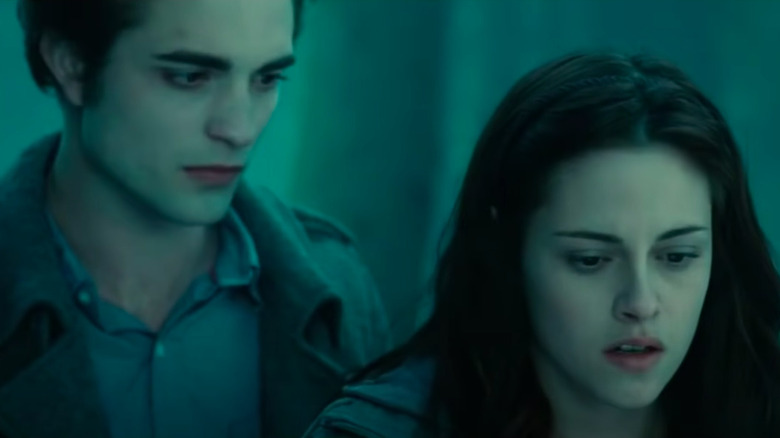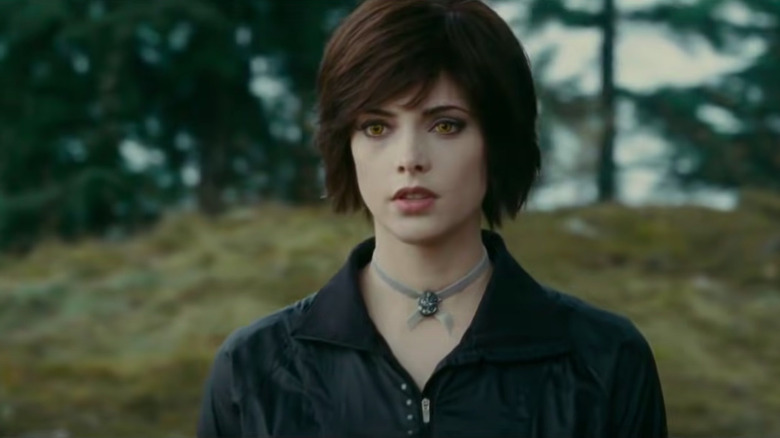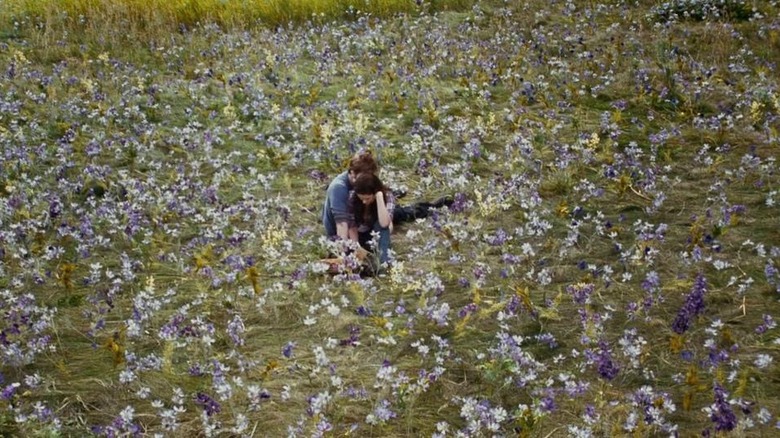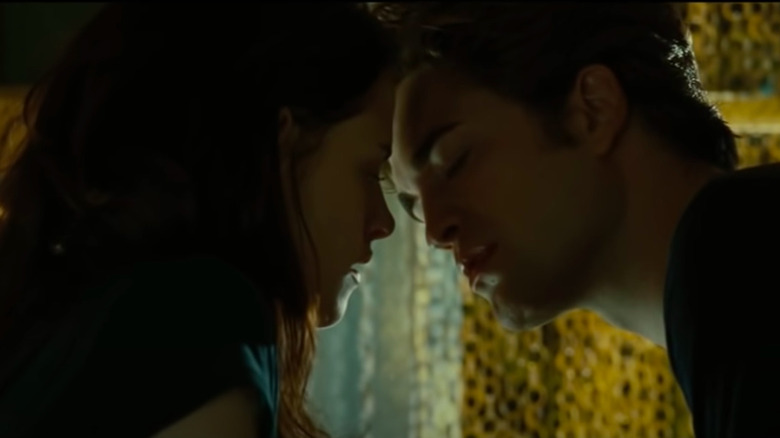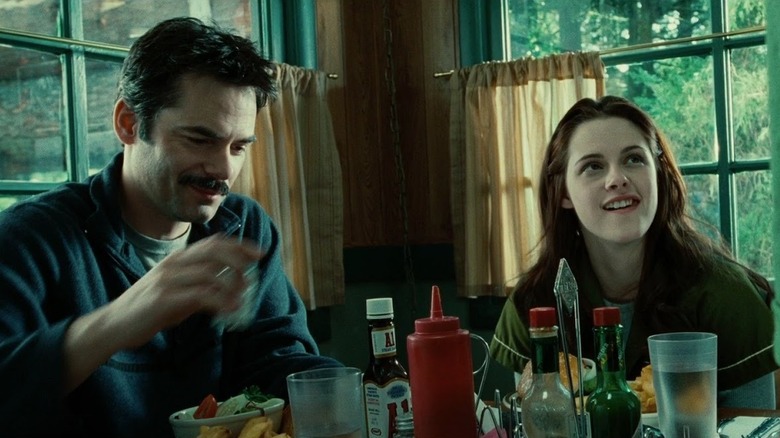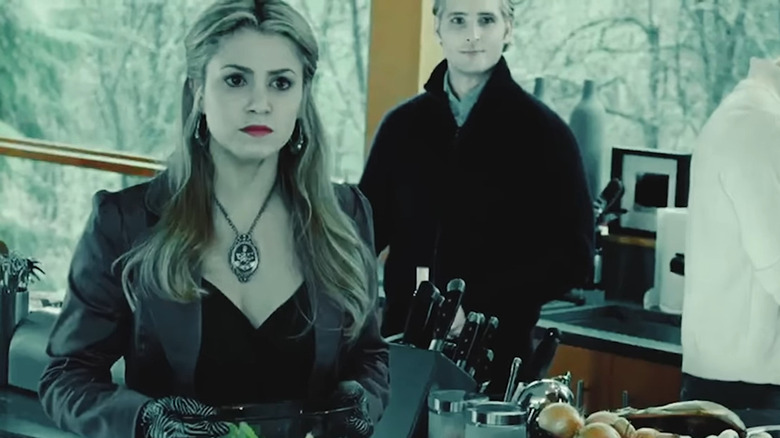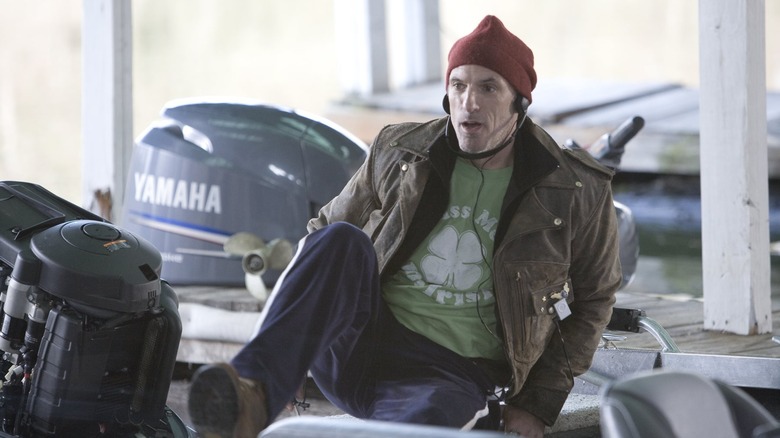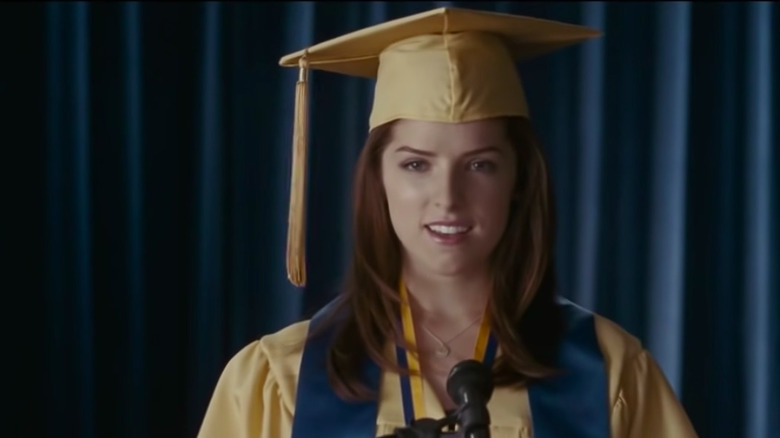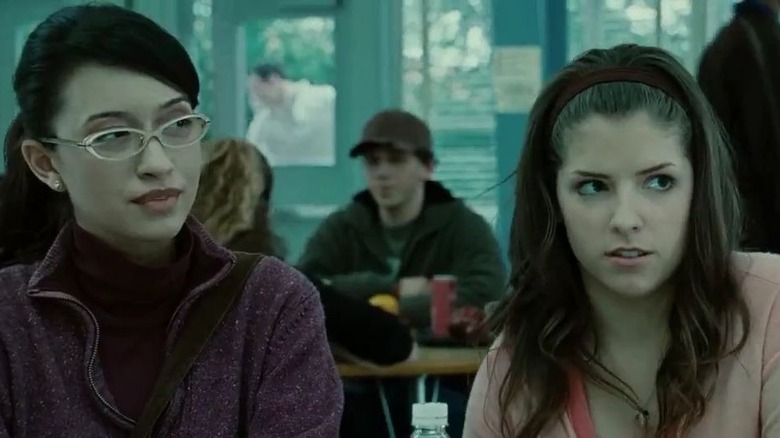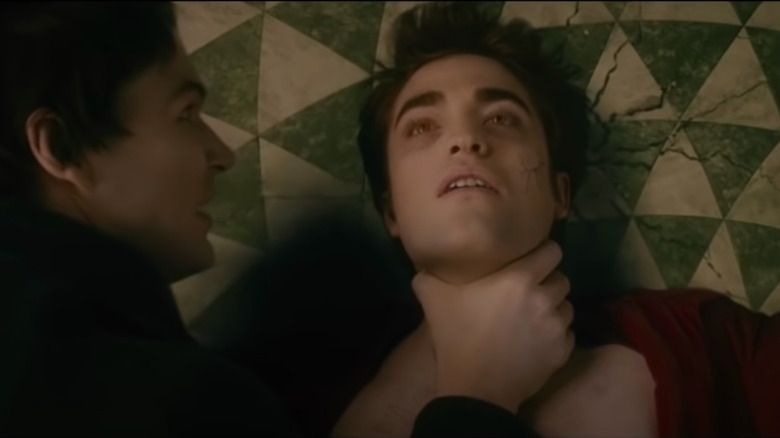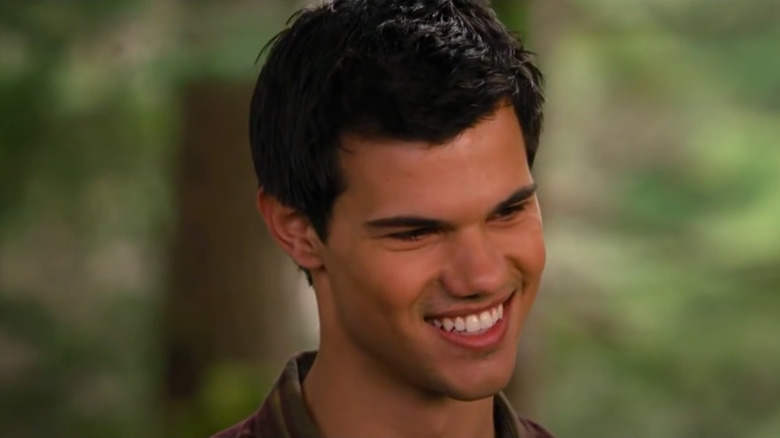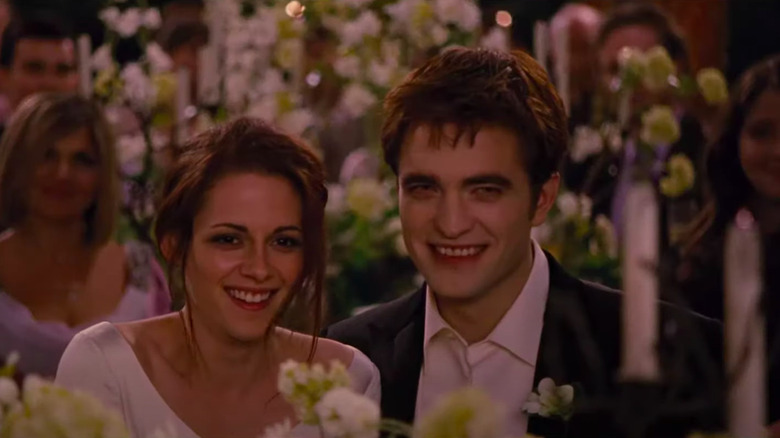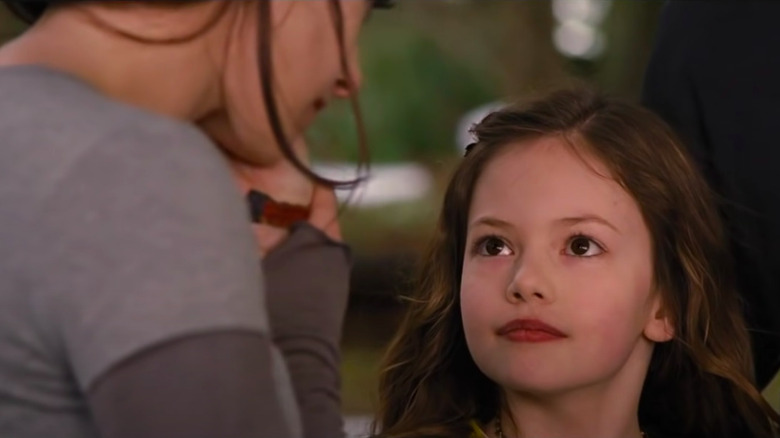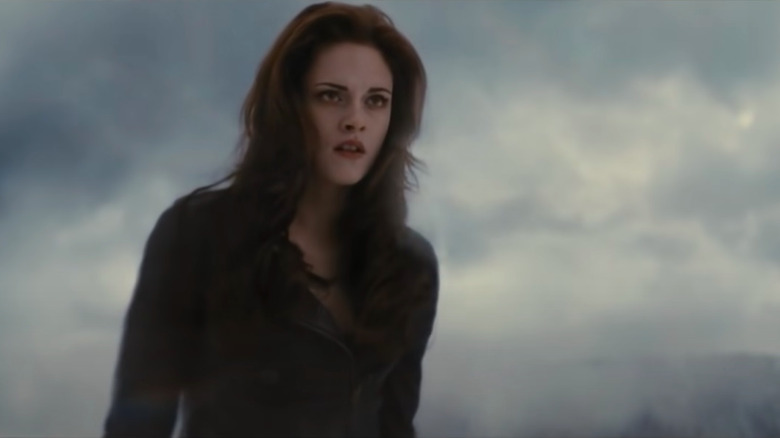Details The Twilight Movie Franchise Gets Wrong From The Books
Twihards, Fanpires, Team Edward, Team Jacob –- as the amount of lingo surrounding the "Twilight" franchise indicates, fans of the series are a dedicated, passionate group. Many readers had an enthusiastic response when the first book was published back in 2005, and the fandom only grew stronger when the first "Twilight" film premiered in 2008. It was the drama, the characters, and the tragic romance of it all that kept them coming back for more, earning the films an astounding $3.3 billion at the box office.
While the film adaptations of the books were clearly a success, at least from a financial standpoint, there are always things that get left behind when a series is adapted from novel to movie form. On a larger scale, certain characterizations tend to change, and entire characters are sometimes added or omitted altogether. On a smaller scale, there are specific details that differ between book and film that only superfans would notice. Whether you're a Twihard or just a casual fan, we thought it would be fun to look back and consider some of the most interesting changes that were made -– for better or for worse -– from the books to the movies.
The famous vampire reveal
One of the biggest changes between the "Twilight" books and the movies is also one of the most notable moments from the first film. If you're any type of "Twilight" fan, you can probably quote the scene from memory. After school one day, Bella stomps off into the misty woods, and Edward follows close behind. She begins listing off his vampiric attributes –- "You're impossibly fast and strong. Your skin is pale white and ice cold ..." –- while he stands menacingly behind her. As the camera spins around them, Bella tells Edward "I know what you are." "Say it. Out loud," he whispers. After a few suspenseful moments, she responds "Vampire."
Powerful stuff, right? But, as it turns out, it wasn't like that at all in the book. In the first book, the conversation between Bella and Edward about how she knows he's a vampire is far less dramatic. Bella describes these same physical attributes to Edward when they are driving back to Forks for Port Angeles in Edward's car. Prior to this conversation, Edward had just rescued her from a group of men who were harassing her (and whose despicable thoughts Edward could read). It's a far more casual conversation in the book than it is in the movie, and in this case, the movie version is much more memorable. Whether you like the more restrained rendition or not, it's clear that director Catherine Hardwick had a distinct vision for this scene, and we're glad she was able to execute it.
Alice's backstory
One of the most interesting aspects of the "Twilight" books is the backstories of all the characters, especially the Cullens. Finding out their stories and how they all came to be a part of Carlisle's family is fascinating, and it adds another layer to their dynamic. In "Eclipse," there are a number of flashback sequences that give greater insight into how the family came to be, such as two scenes where we see both Rosalie and Jasper's journey to becoming vampires. Unfortunately, some of these details had to be cut from the films, presumably to save time.
One of the most disappointing omissions is the backstory of Alice, arguably the most important member of the Cullen family apart from Edward. Alice's tragic tale is fascinating, so it's a shame we don't get to hear more about it in the films. As the story goes, Alice was born in 1901 in Mississippi, and had visions of the future since early childhood. After her mother was murdered and her father threatened her, she was forced to leave home, only to be thrown into a mental asylum because of her visions. While in the asylum, she began having visions of James (who you may recall as the primary antagonist of "Twilight"), a tracker who was hunting her. A vampire friend of hers then turned Alice to give her a chance at survival.
Truth be told, this story could be an entire movie in and of itself, and it's too bad we didn't get to see any of it in the movies. It adds a lot of depth to Alice's character, especially since she comes off as such a happy-go-lucky person in the films.
No college for Bella
One of the biggest criticisms of the "Twilight" books and films is how Bella's love for Edward takes over her life and causes her to stop caring about anything else, including her own well-being. In some ways, this idea was exacerbated in the films because of certain plot points that were omitted.
In the books, Bella actually has plans to attend college despite the unexpected addition of vampires in her life. "Eclipse" actually begins with Bella being accepted into The University of Alaska –- a good environment for vampires -– and Edward being very supportive of her decision to enroll in school. He even urges her to apply to Dartmouth, a school he was accepted into himself.
This plotline is brought up again in "Breaking Dawn," when Bella decides she will go to college for a year after being married and prior to being turned into a vampire. We all know this doesn't happen, of course, because Bella gets pregnant and must be turned into a vampire sooner than planned, but at least the thought was there. There is no such discussion in the films, making it seem like Bella has no other plans for her future apart from being with Edward.
The setting of Edward and Bella's first kiss
First kisses are important in romances, so it's a bit surprising that the tone and setting of Bella and Edward's first kiss differs so much from book to film. In the first "Twilight" book, Edward and Bella's kiss is fairly chaste and sweet, and not all that dramatic. After their day out together in the meadow –- when Edward famously shows Bella how he sparkles in the sunlight -– Edward puts Bella on his back and races back to the car. When they arrive at Bella's truck, Edward very hesitantly kisses Bella, trying to keep his vampiric urges under control as he does so.
In the film, the setting is quite different, and the kiss is significantly more sexualized. Edward has come into Bella's room through the window, and he reveals to her that he has been entering her room this way frequently over the last couple of months because he enjoys watching her sleep. (Creepy, or romantic? You decide.) They have their first kiss –- while Bell is wearing nothing but a t-shirt and underwear, mind you –- and things quickly get heated as Edward pushes her back against the bed. Then, quite abruptly, Edward yells "Stop!" and flings himself across the room.
While the idea of Edward trying to control himself when they kiss is present in both the book and the movie, the film version of the kiss is much more intense. The distinctly PG-13 nature of their kiss and the way Edward violently throws himself across the room is one of the many ways the movies take the more adult themes of the series and make them noticeably more explicit.
The diner setting was added
Overall, the social atmosphere of Stephanie Meyer's is pretty traditional, barring all of the vampires and werewolves. One example of this is found in the books, but not in the movies. For the most part, food does not play a huge part in the "Twilight" universe because vampires don't eat human food, but it does feature every now and again. In "Twilight," it's made clear that both Charlie and Bella are regulars at a diner in town, and that their favorite item on the menu is the berry cobbler. (The diner is also where we see Stephanie Meyer's cameo in the film.)
In the books, however, the diner isn't featured at all. Instead, Bella is frequently found cooking meals for her father, indicating that she does have some skill in the kitchen. It's understandable that this detail was omitted from the film, given that it wouldn't have much bearing on Bella's vampire life, but it is an interesting example of how Bella and Charlie's relationship was conceived of in the book. While Charlie is frequently worried about Bella's wellbeing, this detail also suggests that Bella feels responsible for Charlie's as well, and that she sees herself as his caretaker in some ways.
The Cullens got a makeover with the Cullen Crest
Understandably, the visual elements of "Twilight" are one of the most talked-about elements of the films. Much of this has to do with the films' unique take on the costuming and makeup of the vampire characters, most of whom are seen with brightly colored eyes and extremely pale skin.
While some of these elements were described by Meyer in the books, there's one key detail about the Cullens that Meyer didn't come up with herself. It's revealed in the first "Twilight" film that all of the members of the Cullen family wear what's called the Cullen Crest. The members of the family all wear the crest differently – either as a necklace, a bracelet, or a ring. The crest itself features a lion, three clovers, and an open palm over the top of it. Not much is said about the crest in the film, but if we had to guess we'd say it's meant to represent how close the Cullens are and how they're always connected no matter where they are. By "Breaking Dawn," Bella also wears the crest herself.
Waylon Forge was added for the movie
While it's common for characters or storylines to be removed in film adaptations, sometimes additions are also made. One example of this is the character of Waylon Forge, who is present in the first "Twilight" film but not in the book.
Waylon Forge is first introduced to the audience while Bella and Charlie are eating at the diner. We learn that Waylon is an old friend of Charlie's from the police station and that he used to dress up as Santa every Christmas. One day while working on his fishing boat, Waylon is killed. Charlie and the rest of the townspeople come to the conclusion that it was an animal attack, but the Cullens know the truth –- it was vampires.
Waylon was killed by James, Victoria, and Laurent, who fed on him and then stole his clothes. James is later seen wearing Waylon's jacket, while Victoria dons his "Kiss Me, I'm Irish" shirt. Waylon was clearly created to show the brutality of vampires like James and to introduce Bella into the harsh world of the undead, but it obviously didn't scare Bella away from the Cullens one bit.
Lauren Mallory no longer exists
While characters like Waylon Forge were added to the film, there are other characters who just didn't make the cut. The "Twilight" producers likely knew that fans were more interested in the vampires and werewolves than they were in high school drama, so certain aspects of Bella's high school life were changed from the books to the movies.
One change is the omission of Lauren Mallory, who is a character in the books but not in the films. In the books, Lauren is something of an antagonist to Bella, and is kind of like the school bully. Lauren and her friend Jessica Stanley (who is featured in the films) seem to truly hate Bella, for reasons that aren't quite explained. Lauren's character was cut out entirely in the films, and instead it appears that Lauren and Jessica were combined into one character. In the film, Jessica (played by Anna Kendrick) doesn't like Bella at first and seems a little jealous of her, but definitely doesn't hate her, either. Clearly, Bella has enough going on in her life and doesn't have time to worry about high school bullies.
Bella's friends are inconsequential
Though Bella's relationship with Edward (and to a lesser extent, Jacob) is the central aspect of "Twilight," the books featured a few other plotlines that were mostly left out of the films. One of these elements is Bella's relationship with her high school friends. While the "Twilight" films do show Bella hanging out with a group of friends on occasion, she doesn't seem particularly keen on spending time with any of them or getting to know them as individuals.
While this dynamic is present to some extent in the books, her friendships are given a bit more depth. In particular, Bella does develop an actual friendship with Angela in the book, and she does actually seem to care about her, unlike how these relationships are portrayed in the films. In fact, Bella even finds herself saddened by the idea that she will have to leave Angela behind when she starts her new vampire life. Bella seems to have no such qualms about being with Edward in the films, and her only worry is about what she will tell her parents.
A Volturi fight was added for extra drama
It's a well-known fact that movie adaptations of books tend to add drama and action where it may have been lacking in the source material, and the "Twilight" series is no different. One example of this takes place at the end of "New Moon," when Alice, Bella, and Edward are in Volterra to confront the Volturi. In the book, Bella, Edward, and Alice just have a really tense conversation with the Volturi before they are eventually allowed to leave.
In the film, things are not as peaceful. Volturi leader Aro (Michael Sheen) tells his henchmen Felix to kill Bella, so he lunges at her. Edward jumps in to stop him, so Felix attacks Edward instead, dramatically cracking his head against the marble floor. It's all very dramatic, and much of the fight is shot in slow-motion. It all comes to a head (literally) when Felix is about to rip Edward's head off and Bella offers herself up instead. Aro comes to the conclusion that because Bella knows about vampires, she must be either killed or turned. They are finally allowed to leave after Alice shows Aro a vision of Bella as a vampire in the future.
It makes sense that some action was injected into "New Moon," as it is by far the slowest of the "Twilight" books. Most of the book follows Bella falling into a deep depression after Edward leaves, so we don't blame screenwriter Melissa Rosenberg for trying to amp it up a little bit. Plus, the scene where Edward gets his head smashed is pretty cool, and we love any excuse to see Kristen Stewart screaming at the top of her lungs.
We don't get to see Alice and Jacob's friendship
There are a lot of secondary relationships in the "Twilight" films that don't get developed the way they do in the books. One example of this is the relationship between Alice and Jacob. When Bella is pregnant with Renesme, Alice gets a headache any time she is around Bella because she can't see Renesme's future. Though she wants to be there for Bella, it pains her to be around her, which poses a dilemma.
What Alice discovers is that being around Jacob –- whose future she also can't see since he's a werewolf –- prevents her from getting a headache. This causes a friendship to develop between the two, especially since they both care deeply about Bella and worry about her and the baby. In general, it's nice to see an amicable relationship between Jacob and the Cullens develop, and Jacob and Alice's relationship is the cornerstone of this new understanding between them. It's a shame we didn't get to see more of this werewolf/vampire bonding in the films.
Bella doesn't know Edward was a vigilante
All of the Cullens have fascinating backstories, and the books tend to go much more into detail about the vampires' pasts than the movies. Oddly enough, one character whose backstory is discussed less in the movies than in the books is Edward Cullen himself.
We all know by now that what's most interesting about the Cullen clan is that they're "vegetarians" -– meaning they don't feed on humans, only animals. This wasn't always the case for every member of the family, however. For example, Edward used to be a vigilante. In his early days of being a vampire, he rejected Carlisle's teachings and instead went out at night and hunted criminals, killing them and feeding on their blood.
In the books, Edward first tells Bella about his checkered past in "Twilight" when Bella comes and visits the Cullen house for the first time. In the movies, however, this conversation doesn't occur until the night before their wedding, when Edward tells Bella of his vigilante past so she knows who she's really marrying. He does mention that he's "killed people" in the first movie, but he doesn't elaborate further until that fateful evening. We guess it's considerate that Edward warned Bella about his past before she literally committed herself to being with him for eternity, but couldn't he have done that a little earlier? We're gonna have to side with Meyer's timeline of events on this one.
Renesme grows even more quickly in the movie
The most (in)famous part about "Breaking Dawn -– Part 2" is Bella and Edward's terrifying CGI baby, Renesme. Instead of using an equally terrifying doll, the producers of the film opted to go with CGI, with decidedly unsuccessful results. It's one of the worst parts of a generally off-the-rails film, even if it does bring us some amusement these days.
Luckily, as Renesme grows up, less and less CGI was necessary to create her character. In fact, one the biggest differences between Renesme in the books and in the films is how quickly she grows. In both versions, Renesme grows very fast due to the fact that she's a vampire/human hybrid. By the end of the final book she looks to be about two years old, despite being only a few months old. In the film, however, the oldest version of Renesme is played by actress Mackenzie Foy, who was 10 years old at the time of filming.
While toddler-aged Renesme was an eerie mash-up of Foy's face with the face of a much younger child, the older version of Renesme is, thankfully, just Foy. It's obviously more dramatic to have Renesme grow at an even more rapid pace than in the books, and it cut down on the amount of CGI they had to use for her character, so we can't fault producers for making this particular change.
The fake-out battle of Breaking Dawn – Part 2
The biggest difference between "Breaking Dawn –- Part 2" (which was adapted from the second half of the "Breaking Dawn" book) and the novel is the shocking fight scene –- which actually never happened. The "Breaking Dawn" book features a ton of new vampire characters and many discussions about their abilities and fighting skills, but there isn't an actual fight between the Cullens (and their supporters) and the Volturi.
Anticipating that all of this build-up with no release would be a letdown for audiences, screenwriter Melissa Rosenberg film devised a way to include a fight in the film without totally changing the overall storyline. Leading up the climactic scene, the Volturi –- along with Irina, who initially told them about Renesmee's existence –- face off against the Cullens and their supporters in the middle of a snowy clearing. Alice walks up to Aro and defiantly declares that no matter what she does, the Volturi will attack anyways, and one of the guards grabs her. Carlisle races to save Alice and promptly gets his head ripped off, leading to chaos of the highest degree. Many more deaths follow including Jasper and Aro, as well as several werewolves.
Then, when it seems like all is lost, we flash back to Alice and Aro calming talking and we realize this has all been Alice's vision. We've got to give Rosenberg credit here -– it's a pretty ingenious way to include a fight scene without deviating from the story too much or angering the fans.
